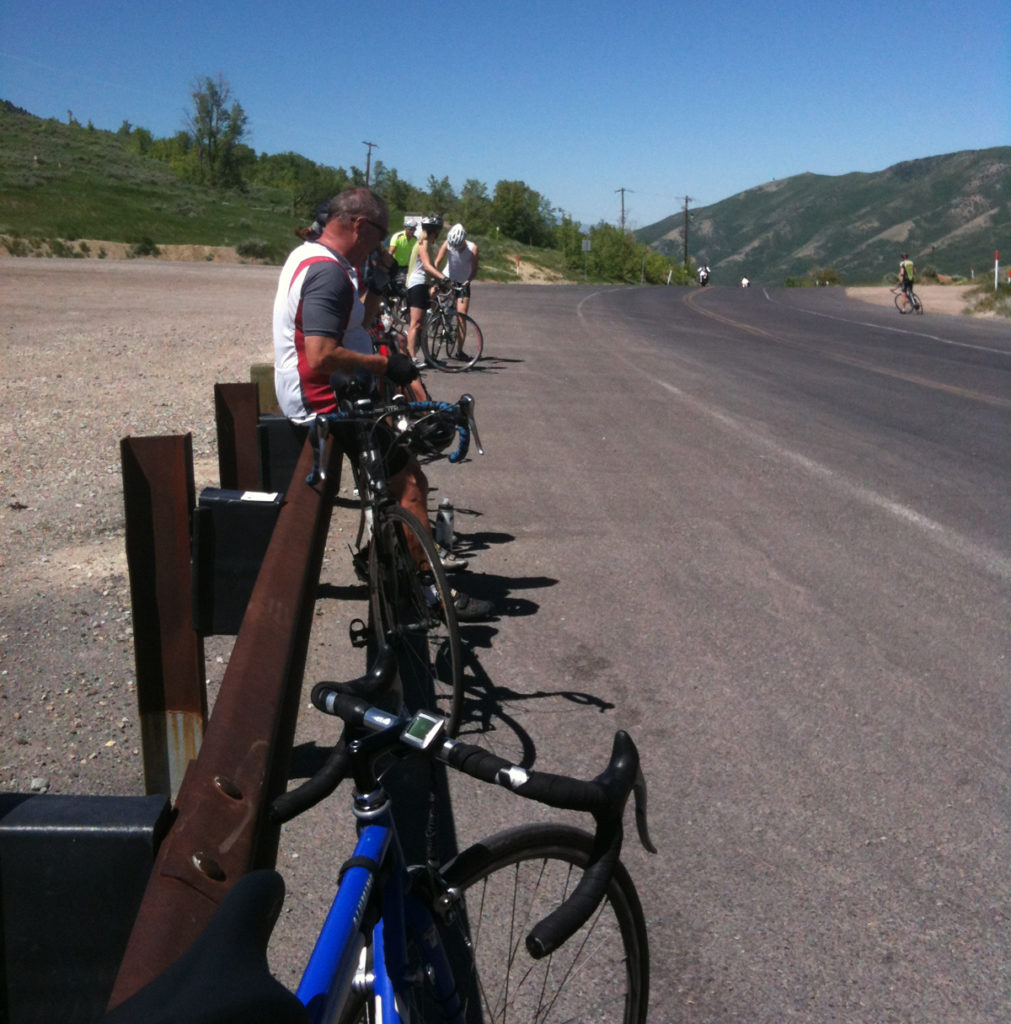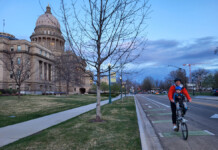SALT LAKE CITY, Utah (June 9, 2020) — Cycling Utah reached out to the Emigration Canyon project team with a number of questions following the recent announcement that the canyon would be closing to cyclists for 3 months starting June 15, 2020.

We asked about access during construction, and roadway design after construction, and we relayed some ideas from the community. The general message is that:
- It will be potentially dangerous for cyclists because of the milling machine and the extent of reconstruction.
- There’s a chance of doing the road in segments that would allow some cycling during construction. Updates to follow. A key question is whether to start construction at SR65 and go towards Salt Lake City, or vice-versa.
- There’s a chance that the project will take less than 3 months.
- Residents may have different access conditions.
- There’s a chance of speed limit reductions in some areas.
- Lane widths may be adjusted to give more room to cyclists.
- The short notice was due to circumstance around the availability of the contractor and funding.
- Soft spots (areas with poor subsurface) total at least 6000 square yards, and require extensive reconstruction.
- More updates to follow.
Design opportunities:
The biggest opportunity that we see is to request narrower travel lanes throughout the canyon (12’ to 11’). This design change would:
-
- Give more room for bikes.
- Slow vehicle travel speeds.
- Be safer for bikes, peds, wildlife, and motorists.
We will provide updates as we find out more information.
Reference (note, we have not yet evaluated the study to see how it connects to the project): Emigration Canyon Roadway Improvement Study
In discussion with the project manager, because of many required repairs to drainage and to the roadway, there was not enough budget to implement everything in the study referenced above.
New: Emigration Paving Project Website with scheduling info
Project Manager Steve Quinn’s response to Cycling Utah is below:
First of all, thank you for your thoughts on the planned closure of Emigration Canyon. Also, please understand that this decision was not taken lightly. Many options were discussed but the final decision came down to one of safety. As you know the canyon is very narrow. When the contractor closes one lane for work, and establishes a safe work zone, the remaining lane which will require flagging, in most locations may be less than 11 feet wide including any shoulder. That is too narrow to safely support a bicycle and a vehicle. On evenings and weekends there will very likely be open milled surfaces with a 2+ inch drop from the roadway surface. Vehicles have very little problem navigating those conditions. For cyclists it would be very dangerous.
There are probably a few other things you need to know about the project that will help with understanding our decision.
-
-
- The pavement in the canyon is in terrible condition. We have estimated significant areas that require what we call soft spot repair (places where the pavement and sub-material must be completely removed and re-installed, essentially reconstructing sections of the shoulder or roadway, which takes significantly more time).
- There are several areas where the contractor will be adjusting the profile (slope) of the road in order to improve drainage,
- and finally, they will be replacing a 24 in storm pipe that will cut across the entire roadway at one location.
-
The contractor is allowed to have two work zones (up to two miles each) active at any given time so they can replace the pipe or get out ahead of the soft spot repair while they are doing the mill and overlay work in another area. We gave the contractor this latitude in an attempt to get the project completed as quickly as possible.
I am sure you have seen a milling machine on the road before. They are extremely large. The contractor will select the machine they will use (there are different width machines to minimize the number of passes required to mill the road). They are very likely to select an 11’ or 12’ wide machine. The milling machine literally grinds off the existing pavement, in this case, the top 2” and throws that material into a dump truck that is following behind. The remaining surface is very rough with ridges and lots of loose materials. Dump trucks will be constantly present in the canyon either removing the mill tailings or bringing in new asphalt for the paving machine which is equally as large as the milling machine, again to reduce the number of passes required to do the work. By the time we get those large machines on the road and all the barrels to establish the work zone, you can see how narrow the available travel space will become. That is why we are so concerned with the safety of cyclists in or around the work zones.
The project will be constructed in segments so there may be the possibility of keeping some of the canyon open to cyclists as you suggest, but it needs to be segmented in a way that makes sense for all parties. We need to take all factors into consideration when looking at the segments. There is not parking available in the canyon to allow segments that start and end within the canyon. We also need to give the contractor flexibility in doing the work so that everything can be completed this year. However, we may be able to consider the following:
Keep the East end open (from SR-65 to Pinecrest for example) while they work on the West end (mouth of the canyon to Pinecrest). When the West section is complete, we could open it for cycling while they complete the work on the East end. Or possibly reverse it and start on the East end.
It seems that phasing the work like that would still give the contractor a chance to get out ahead of the milling to fix soft spots and still accommodate some cycling. We plan to discuss this with the contractor, but I cannot make any promises at this time. The mayor is in favor of this type of phasing.
Concerning the new striping and lane widths, here is the planned layout.
-
-
- From the County line to the Fire Station in the eastbound (uphill) direction there will be a five (5) foot bike lane. Twelve (12) foot travel lane to Skycrest. Eleven (11) foot travel lane from Skycrest to the Fire Station.
- From the County line to the Fire Station in the westbound (downhill) direction it will remain “Share the Road”. Twelve (12) foot travel lane.
- Between the Fire Station and Pinecrest it will continue to be “Share the Road” because there is insufficient room through that section to strip for bike lanes. Eleven (11) foot travel lanes in both directions.
- Between Pinecrest and the Summit there will be five (5) foot bike lanes on both sides of the road. Twelve (12) foot travel lanes in both directions.
- From the Summit to SR-65 once again it will be “Share the Road” because of how narrow the road is. Eleven (11) foot travel lanes in both directions.
-
We very much wanted to expand the bike lanes, but the project simply was not funded to be able to add the width necessary to support additional bike lanes. Travel lanes were only adjusted where necessary to provide five (5) foot bike lanes.
The County is evaluating the speed in the canyon right now for the Mayor and Council. There is discussion of adjusting the speed to 35 MPH between the Fire Station and Pinecrest. The Mayor was not, last thing I heard, considering adjusting the speed in other areas but the speed study will help make those decisions.
Signage in the canyon is being handled by the County and not by the roadway contractor. We designed upgrades and additional signage to go along with the changes in the bike lanes. Additional signage will be up to the Mayor and County based on available funding.
To address the additional comments from the community, see my comments and questions below?
-
-
- A shuttle for cyclists – this item confuses me. Where would people want to be shuttled to and from?
- Downhill access should be ok – Do a lot of people travel the canyon one-way downhill? That could be considered, but remember it is uphill from SR-65 where the road is the very narrowest and uphill from Salt Lake. There is no way to always go downhill. Going downhill doesn’t remove the dangers of the narrow work zone.
- Access on weekends – this is being considered, but it is much more difficult than people can imagine. The contractor will have to make sure at the end of the day every Friday that every place the pavement was cut or milled has been re-paved, cleaned up, and made safe. Cars can safely navigate open pavement cuts or milled surfaces. Bikes cannot. It could also significantly increase costs because all the barrels will need to be removed and stored off-site to free up the shoulders and bike lanes versus just being pushed to the shoulder out of the travel lanes.
- Access in early morning and evenings – Like the response above it is even more difficult and more costly to make sure the road is open and safe at the end of every day.
- Stagger the section of construction starting at SR-65. – See my response above about dividing the canyon into two segments.
- A way to disseminate information on construction and closures – we have an email list people can subscribe to for weekly updates and we are looking into Twitter as a tool.
- Passes for residents – We are discussing how to handle residents as the rules will likely be different from those for the recreational rider.
-
We held a meeting yesterday with UDOT, the Mayor, and Salt Lake County to discuss options for cyclists. We have a plan of action we will be discussing with the contractor to see if accomodations can be made to not fully close the canyon to cyclists. I will let you know what comes of those discussions.
I happen to be one of the many people who loves to ride this canyon and I do it on a regular basis. I hate to lose the opportunity for this summer as well, but I also know that once it is complete it will be a safer and more comfortable ride on the new pavement for many years to come. If you have additional questions, please do not hesitate to reach out to us again.
Thanks,
Steve
Steven J. Quinn
Project Manager
Questions or Concerns?
Salt Lake County and Emigration Township have established a dedicated public information team for this project. For more information, or to leave feedback, call 877-495-4240, or send an email to aalbrecht@pec.us.com.









I’m glad to hear the road is being reworked. The closure to bikes is a temporary inconvenience toward a long term benefit.
Hopefully an enforceable lower speed limit is imposed thru out E canyon.
Hi All, having biked up Emigration Cyn since the early 80’s I have witnessed great improvements. Some were quite slow in coming like the first left turn that we used to call Suicide Corner. It took a decade to fix this. I have yet to review how this new 3 month project will improve this coveted bike route. I understand there is not enough $ to complete the bike route but hopefully they will put in place the structures to complete it at a time not too far into the future.
Emigration should be improved to provide MAXIMUM safety for cyclists. I would like to know what the cyclist count is. I would guess 1000 rides a week up Emigration. Some additional “curbing” to keep rock fall off the road would be a huge improvement.
The closure in painful, but we should be grateful. I had assumed the seemingly inevitable budget deficits created by Covid-19 it would delay repaving for another 10 years. The new pavement may make the groups of sports cars and motorcycles want to drive faster.
I have been riding Millcreek Canyon since the closure and Emigration was in better shape than Millcreek is. The steep decent, potentially wheel busting pavement patches, and the shadows which prevent seeing the pavement at the edge of the road makes Millcreek dangerous. You can try to keep up with traffic on the descent and risk breaking a wheel at 30+ MPH or slow down and risk getting hit.
I would like to thank the residents of Emigration canyon for their thoughtfulness and courtesy towards cyclists. With the exception of the 40ish blonde guy in the white car with the bright orange mountain bike on the back. He needs some prison time. It would be nice if more people driving from the University area to Park City would take I-80.
Some signage regarding the closure at the bottom of the canyon would have been helpful. I access Emigration from Wasatch Dr E and I found out the hard way. Which is when I met the guy in the white car.
I believe Emigration one of the safest cycling routes in SL County. Mostly due to the courtesy of the inhabitants. No expense should be spared to make it safer.
As of Saturday Aug 1 the road is paved to the first switchback and striped to the fire station. There is one short section in the downhill lane below the fire station which did not get paved. We are getting close. They are paving the switchbacks and the road from the top to Little Dell is milled.
This is old news but the worst parts of Millcreek were repaved in one week. It is much better now.
Comments are closed.